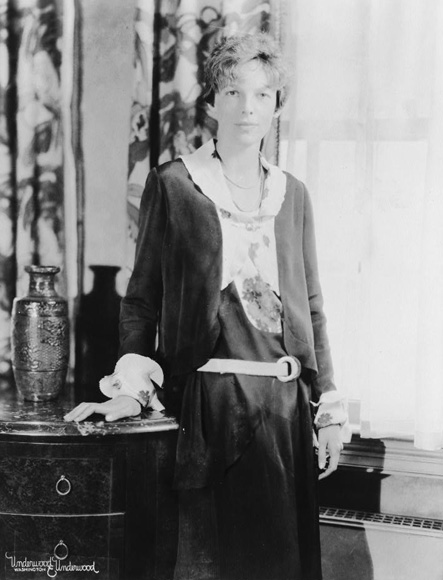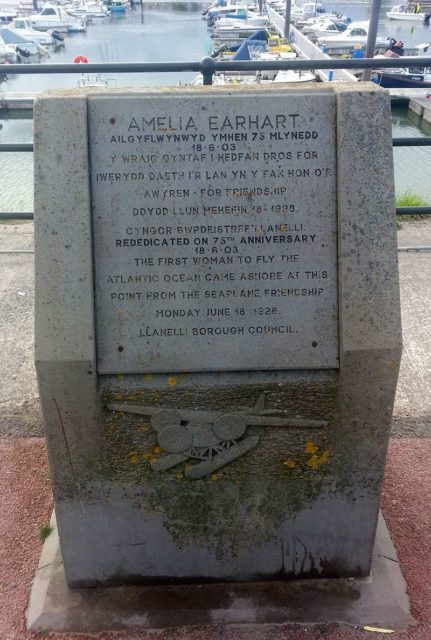On July 2, 1937, aviator Amelia Earhart’s plane disappeared during an attempt to fly around the world.
In 1920, Earhart was a passenger on a flight piloted by Fred Hawks. It was at that moment she decided she needed to fly. A year later she graduated from the Curtis School of Aviation, and with money borrowed from her mother, bought her first airplane. In 1932, she became the first female pilot to traverse the Atlantic. Upon her return, she found herself at the center of a media circus. Amelia received a call from President Calvin Coolidge, was the guest of honor in a ticker-tape parade in New York City, and was invited to parties and dinners in her honor. She was even consulted by Lockheed Aircraft on designs for future airplanes.

In 1929, Amelia joined the Women’s Air Derby along with eighteen other women pilots. The task was to race from Santa Monica, California to Cleveland, Ohio. According to ameliaearhartmuseum.org, Amelia called it “A chance to play the game as men play it, by rules established for participants as flyers, not as women.” Amelia came in third place and won $875. More importantly, the race brought attention to women pilots and was instrumental in creating an organization catering to them. On November 2nd, 1929, twenty-six female pilots met in Valley Stream, New York, to form the organization called the Ninety-Nines. Amelia became the first elected president in 1931. The only requirement for membership was to be a female licensed pilot. The organization is still active today and manages the Amelia Earhart Birthplace Museum in Oklahoma City, as well as awarding scholarships for women’s flight training and study in aviation.
On June 1st, 1937, Amelia and Fred Noonan, her navigator, took off in a Lockheed Electra twin engine aircraft from Miami, Florida in an attempt to circumnavigate the globe along the equator. They made stops for fuel and supplies in South America, Africa, India and New Guinea. The next scheduled stop was Howland Island not far from Fiji in the Pacific Ocean. The aircraft never arrived.
Searches were conducted, but no definitive evidence was discovered. Since then there have been countless speculations on what may have happened. Some believe that Amelia’s quest to fly around the world was a cover up for a spy mission, and that Amelia and Noonan were captured by the Japanese after making a landing in an unknown place. The most popular belief, however, is that the airplane ran out of fuel and crashed into the Pacific Ocean.
The International Group for Historic Aircraft Recovery (TIGHAR), has been investigating the disappearance of Earhart’s plane for over twenty-five years and have narrowed their search to a small atoll in the Pacific about 350 miles to the southeast of Howland Island called Nikumaroro Island (previously known as Gardner Island).

Secret telegrams between Gerald Gallagher, Officer-in-Charge, Phoenix Islands Settlement Scheme (P.I.S.S.) and several high-ranking authorities among Western Pacific High Commission (W.P.H.C.), and the Gilbert & Ellice Islands Colony (G. & E. I. C.) have been reproduced on the TIGHAR website indicating that in 1940 a skull was found on Nikumaroro and was immediately believed to be Earhart’s. Also discovered were part of a woman’s shoe and what was believed to be a sextant’s box. There were also remnants of a campsite. Upon examination, the bones were first believed to be those of a Polynesian male which had been lying exposed for more than twenty years. Unfortunately, Gallagher died in 1941, and the matter seems to have been shelved. No one knows what happened to the bones, but more recent conclusions based on original research notes suggest that they may have belonged to a female of European descent who was about 5’8” tall, which matches what we know about Earhart. Without access to the original bones, nothing can be proved.
In a recent presentation, Ric Gillespie, Executive Director of TIGHAR, has reported that over one hundred known reports of distress calls sent by Earhart were received for approximately four days after her plane disappeared. Although many of these claims have been dismissed, there are reports from short wave radio operators in Texas, California, Florida and Australia that have been deemed credible, News.com.au reported.
This leads researchers to believe that Earhart landed on the atoll at least partially on dry land in order for her radio to be working. Transmissions indicated that while Earhart was only slightly injured, her navigator was in more serious distress. Several of the transmissions even included navigational coordinates. This has led TIGHAR to the conclusion that Earhart and Noonan died as castaways on Nikumaroro.
TIGHAR intends to continue the search for Earhart’s airplane which is believed to have been washed out to sea, but unforgiving underwater terrain and lack of funding has made this difficult. A new search using submarines is planned for July of 2017.
https://www.youtube.com/watch?v=srRbgAe0xRM
